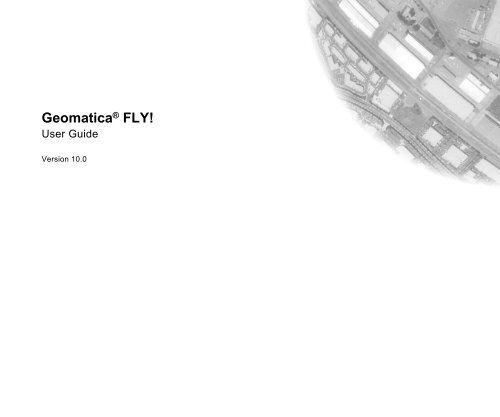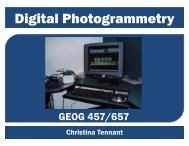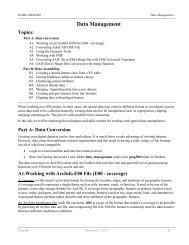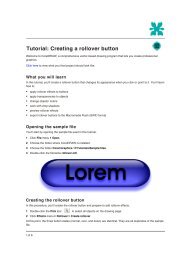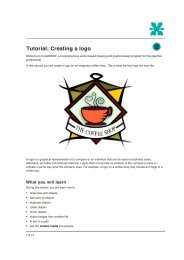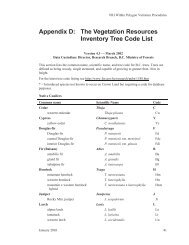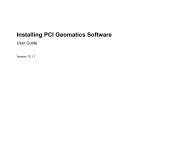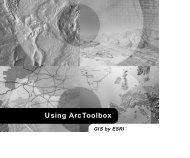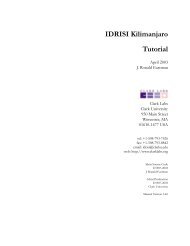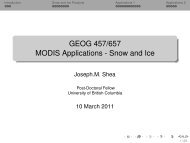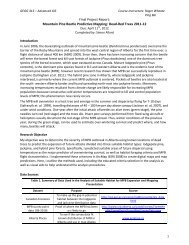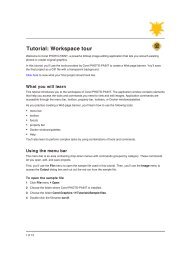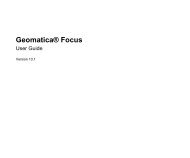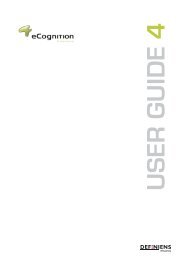FLY! User Guide.book - UNBC GIS Lab
FLY! User Guide.book - UNBC GIS Lab
FLY! User Guide.book - UNBC GIS Lab
Create successful ePaper yourself
Turn your PDF publications into a flip-book with our unique Google optimized e-Paper software.
Geomatica ® <strong>FLY</strong>!<br />
<strong>User</strong> <strong>Guide</strong><br />
Version 10.0
© 2005 PCI Geomatics Enterprises Inc.®. All rights reserved.<br />
COPYRIGHT NOTICE<br />
Software copyrighted © by PCI Geomatics, 50 West Wilmot St., Suite 200, Richmond Hill,<br />
ON CANADA L4B 1M5<br />
Telephone number: (905) 764-0614<br />
RESTRICTED RIGHTS<br />
Canadian Government<br />
Use, duplication, or disclosure by the Government is subject to restrictions as set forth in DSS<br />
9400-18 "General Conditions - Short Form - Licensed Software".<br />
U.S. Government<br />
Use, duplication, or disclosure by the Government is subject to restrictions set forth in<br />
subparagraph (b)(3) of the Rights in Technical Data and Computer Software clause of<br />
DFARS 252.227-7013 or subparagraph (c)(1) and (2) of the Commercial Computer Software-<br />
Restricted Rights clause at 48 CFR 52.227-19 as amended, or any successor regulations<br />
thereto.<br />
PCI, PCI Geomatics, PCI and design (logo), Geomatica, Committed to GeoIntelligence<br />
Solutions, GeoGateway, <strong>FLY</strong>!, OrthoEngine, RADARSOFT, EASI/PACE, ImageWorks,<br />
GCPWorks, PCI Author, PCI Visual Modeler, and SPANS are registered trademarks of PCI<br />
Geomatics Enterprises, Inc.<br />
All other trademarks and registered trademarks are the property of their respective owners.
Table of Contents<br />
INTRODUCING <strong>FLY</strong>!<br />
How to Use this Manual ................................................................................................................................................................................3<br />
What you can do with <strong>FLY</strong>! ...........................................................................................................................................................................4<br />
Chapter 1<br />
GETTING FAMILIAR WITH <strong>FLY</strong>!<br />
Using the Main Panel ....................................................................................................................................................................................5<br />
Managing Vector Layers .............................................................................................................................................................................10<br />
Defining Raw Database Files......................................................................................................................................................................11<br />
Creating a Flight Path .................................................................................................................................................................................12<br />
Chapter 2<br />
<strong>FLY</strong>ING THROUGH THE TERRAIN<br />
Controlling Flight in the Rendering Window ................................................................................................................................................17<br />
Editing Rendered Images............................................................................................................................................................................20<br />
Checking Performance on Your System .....................................................................................................................................................24<br />
1
Chapter 3<br />
RUNNING A <strong>FLY</strong>! DEMO<br />
Opening <strong>FLY</strong>!..............................................................................................................................................................................................25<br />
Loading the Terrain.....................................................................................................................................................................................26<br />
Controlling Your Flight.................................................................................................................................................................................29<br />
Flying Through Your Terrain .......................................................................................................................................................................30<br />
Creating a Flight Path .................................................................................................................................................................................31<br />
Generating a Movie Loop............................................................................................................................................................................32<br />
Appendix A<br />
USING <strong>FLY</strong>! FROM THE COMMAND LINE<br />
Using Command-line Switches ...................................................................................................................................................................35<br />
Appendix B<br />
ADDITIONAL INFORMATION<br />
Memory Usage and Speed Hints ................................................................................................................................................................37<br />
Motif Customization.....................................................................................................................................................................................37<br />
High Background Value ..............................................................................................................................................................................38<br />
Converting Image Files to Digital Video......................................................................................................................................................38<br />
Floating Symbols.........................................................................................................................................................................................38<br />
Heads-Up Display (HUD)............................................................................................................................................................................39<br />
Vector Display.............................................................................................................................................................................................39<br />
Index ..........................................................................................................................................................................................................41<br />
2
Introducing <strong>FLY</strong>!<br />
Welcome to the <strong>FLY</strong>! <strong>User</strong>’s <strong>Guide</strong>. <strong>FLY</strong>! is a digital imaging tool<br />
that shows imagery and terrain data using digital graphic<br />
technology. <strong>FLY</strong>! drapes airphoto and satellite imagery over a<br />
Digital Elevation Model and then instantly creates a 3-D perspective<br />
scene that you can navigate in real time<br />
You can alter your speed, elevation, and view and adjust any of the<br />
perspective parameters during flight. To control your flight - just<br />
point and click. Create stationary hover perspectives or program a<br />
custom flight path with several flight parameters that you select.<br />
You can overlay vector data to enhance the simulation. Identify key<br />
areas, isolate specific structures, add lines of sight, show electrical<br />
power corridors, railways, place names, and much more. You can<br />
even simulate adverse weather conditions with the <strong>FLY</strong>! fogging<br />
feature.<br />
In addition to interactive flight you can predetermine a flight path<br />
ahead of time. Select the precise points that make up your custom<br />
flight plan using the nadir image as your guide. Save your image<br />
files in a variety of formats or export them for conversion to video<br />
file formats.<br />
How to Use this Manual<br />
This <strong>FLY</strong>! <strong>User</strong>’s guide is divided into four chapters:<br />
3
- Introducing <strong>FLY</strong>!<br />
Introduction introduces the features of the software and has a<br />
few suggestions for using <strong>FLY</strong>! in your work. Built-in flexibility<br />
allows you to use your own creativity for discovering new uses. Use<br />
this chapter to review the features of <strong>FLY</strong>!.<br />
Chapter 1 contains preliminary instructions and references to<br />
help you become familiar with the main software components. Refer<br />
to this chapter for details about what you can do and how to set up<br />
files with the <strong>FLY</strong>! Graphical <strong>User</strong> Interface.<br />
Chapter 2 provides details about managing vector layers and<br />
using the various components of the software to customize your<br />
<strong>FLY</strong>! session to suit your needs. Use this chapter to learn how to<br />
customize your setup and to control your flight in real time.<br />
Chapter 3 reviews the main functions of <strong>FLY</strong>! using the demo<br />
files provided on the CD-ROM. It is intended to get you up and<br />
running quickly. Follow the steps carefully and you’ll be a <strong>FLY</strong>!<br />
expert in no time.<br />
You can review Chapters 1, 2, and 3 or go directly to the demo in<br />
Chapter 4 for a quick start.<br />
For supplementary information about running <strong>FLY</strong>! from the<br />
command line under both Windows and Unix turn to the appendixes<br />
at the back of this guide.<br />
What you can do with <strong>FLY</strong>!<br />
Because <strong>FLY</strong>! uses PCI Geomatics’ GeoGateway technology, it<br />
supports direct data loading from dozens of file types and <strong>GIS</strong>/CAD/<br />
Map formats.<br />
• Mission rehearsal<br />
• Non-intrusive reconnaissance<br />
• Visual Environmental Assessment<br />
• Determination of geological structure<br />
• DEM quality assessment<br />
• Public and Management presentations<br />
<strong>FLY</strong>! is available for Windows, Unix, and Linux operating systems.<br />
With <strong>FLY</strong>! you can:<br />
• Create a terrain using elevation data and color information from an<br />
image database file.<br />
• Specify a directional light source through shaded relief.<br />
• Save terrain renderings to an image file on disk in a variety of<br />
formats. Rendered scenes can be imported or printed by other<br />
software packages.<br />
• Produce a true vector overlay. All GeoGateway vector formats are<br />
supported.<br />
• Create a flight path composed of several user-specified nodes<br />
selected from the nadir image.<br />
• Store the position, direction, and speed parameters in addition to<br />
pitch, view cone, and zoom levels for each node in a flight path.<br />
• Play back your flight with VCR type controls, or set <strong>FLY</strong>! for<br />
continuous playback with a single mouse click.<br />
<strong>FLY</strong>! is the ideal tool for applications where terrain exploration is<br />
essential:<br />
• Mission planning<br />
4 PCI Geomatics
C HAPTER<br />
1<br />
Getting Familiar with <strong>FLY</strong>!<br />
This chapter introduces you to the <strong>FLY</strong>! Graphical <strong>User</strong> Interface<br />
and gives details about the many features and functions of <strong>FLY</strong>!<br />
Figure 1.1 The <strong>FLY</strong>! Control Panel<br />
Using the Main Panel<br />
The main panel is the central control for all of the <strong>FLY</strong>! features and<br />
settings. It has a menu bar with four menus, four function<br />
commands, and a message area.<br />
Figure 1.1 on page 5 shows the Control panel and the names of the<br />
control commands. The command areas are listed below with a brief<br />
description of what they do.<br />
A<br />
B<br />
C<br />
A. Control Panel command B. <strong>User</strong> Free Flight command<br />
C. Nadir View command D. Flight Path Editing command<br />
E. Message area F. Menu bar.<br />
D<br />
E<br />
F<br />
A Opens the Control Panel to provide a graphical interface. Use the<br />
Control panel to change your position, direction and speed<br />
characteristics.<br />
B Puts <strong>FLY</strong>! into controlled free flight. You control the flight<br />
interactively while moving through your terrain.<br />
5
Chapter 1 - Getting Familiar with <strong>FLY</strong>!<br />
C Opens the Nadir panel to provide an overhead view of the terrain.<br />
Use the Nadir panel to create a flight plan.<br />
D Opens the Flight Editing Panel to create and play flight plan<br />
movies.<br />
E Message area to display brief messages and to show progress of<br />
some actions. Descriptive text appears when your mouse passes over<br />
a function command.<br />
F Menu bar with four menus File, Edit, Options, and Help. The<br />
menu commands are explained below.<br />
Loading Elevation and Color Data<br />
<strong>FLY</strong>! generates terrains using elevation data and color information<br />
that you choose from an image database file. Use the File menu to<br />
access the functions that load DEM and color datasets.<br />
Monochrome terrains require one color channel to specify<br />
brightness. To create black and white terrains select the Load DEM<br />
+ BW option from the File menu.<br />
8-bit pseudo color terrains require one color channel. The Load<br />
DEM + Pseudo Color option is used with 8-bit color imagery such as<br />
8-bit TIFF, BMP and SPANS files. The color information is<br />
automatically loaded with the imagery data. To create a pseudo color<br />
terrain, select the Load DEM + Pseudo color option from the File<br />
menu.<br />
The Load DEM Shade RGB and the Load DEM shade BW<br />
commands create images that show sunlight throughout the terrain<br />
using a technique known as shaded relief.<br />
Each of the Load file commands opens a different panel with more<br />
controls for loading and creating specific terrains. Figure 1.3 shows<br />
the Load Elevation and Color panel.<br />
Figure 1.2 The <strong>FLY</strong>! File menu<br />
Full color terrains require three color channels, one each for red,<br />
green, and blue. To create full color terrains select the Load DEM +<br />
RGB command from the File menu.<br />
6 PCI Geomatics
Using the Main Panel<br />
Figure 1.3 Load Elevation and Color panel<br />
a database file the Database Channels window opens. Elevation and<br />
color channels are listed together in this window.<br />
Figure 1.4 Database Channels Window<br />
To load an elevation channel:<br />
• Choose the elevation data from the list and click Select.<br />
If a file has not been selected, a file selection panel is displayed<br />
prompting you to select a file.<br />
You can reduce the effect of sharp changes in the elevation model<br />
with the Elevation Smoothing option.<br />
All <strong>FLY</strong>! data files are loaded through panels similar to the Load<br />
Elevation and Color panel shown above. Below is an explanation of<br />
the key parts of the <strong>FLY</strong>! panels and the windows that open from the<br />
panels.<br />
Loading Elevation Data<br />
The Select Elevation File command on the Load Elevation and Color<br />
Panel opens the Database File Selection window. When you choose<br />
• In the Elevation Information section of the Load Elevation and Color<br />
panel, select one of the following from the Elevation Smoothing<br />
menu. The list below shows how each elevation option effects the<br />
elevation model.<br />
None<br />
Slight<br />
2<br />
Medium<br />
3<br />
no smoothing performed<br />
5 x 5 Gaussian filter with standard deviation<br />
5 x 5 Gaussian filter with standard deviation<br />
OrthoEngine <strong>User</strong>’s <strong>Guide</strong> 7
Chapter 1 - Getting Familiar with <strong>FLY</strong>!<br />
Extreme<br />
4<br />
5 x 5 Gaussian filter with standard deviation<br />
• Root for square root enhancement<br />
• Equalize for histogram equalization<br />
Loading Color Information<br />
The Select Color File command on the Load Elevation and Color<br />
panel opens the Database Channels window for selecting color<br />
channels. Color channel data appears in the same list as elevation<br />
data.<br />
Figure 1.5 Database Channels window<br />
When you select a color channel, the values appear in the boxes<br />
below the database channels list. If you have not selected an<br />
elevation or color file, a file selection panel opens to choose an<br />
image database file.<br />
For 24-bit RGB and 8-bit black and white data, you can specify a<br />
color enhancement for each color channel in the terrain with the<br />
Load Elevation and Color panel.<br />
In the Color Enhancement list, select:<br />
• Linear for linear enhancement<br />
Adjusting Database Information<br />
The Load Elevation and Color panel has four image<br />
adjustments:<br />
• Pixel Size to specify the size for each pixel relative to the ground.<br />
Database pixels are square and are measured in square meters. The<br />
default value is 1.00 meter. For PCIDSK files, pixel size values will<br />
be read and filled in automatically.<br />
• Pixel Height specifies the height of one elevation unit. For example,<br />
if the digital elevation model value is 1,000 and the pixel height is<br />
1.00 meter. then the real elevation is calculated at 1000 m. Similarly,<br />
if the pixel height is 10 m, the real elevation is 10,000 m. The default<br />
value is 1.00 meter.<br />
• Terrain X Size determines the size of the terrain. The elevation data<br />
region can be a different size and ratio from the created terrain. The<br />
data is scaled up or down accordingly. This field is automatically<br />
updated to the size of the elevation data. It can be overridden<br />
manually.<br />
• Terrain Y Size determines the size of the terrain. The elevation data<br />
region can be a different size and ratio from the created terrain. The<br />
data is scaled up or down accordingly. This field is automatically<br />
updated to the size of the elevation data. It can be overridden<br />
manually.<br />
Selecting Data Channels<br />
In the Database Channel selection window, select one or more color<br />
channels to define your terrain. The database channels appear in the<br />
list with a description of the source, data type, and a description for<br />
the file.<br />
8 PCI Geomatics
Using the Main Panel<br />
To select an image channel:<br />
Figure 1.6 Load Elevation and Shade in Full Color panel<br />
1. Click on the desired channel<br />
2. Click the Select command.<br />
3. To close the Database channels window and save your selection,<br />
click the Select and Close command.<br />
Below the list is a caption showing the type of channel you are<br />
selecting. Next to the caption is a blank text field for database<br />
channel numbers. When a text field contains a number, it indicates<br />
that the corresponding channel number is being used for<br />
information.<br />
There are Clear and Default commands beneath the captions and text<br />
fields.<br />
• Click the Clear command to erase the field.<br />
• Click the Default command to enter a default channel.<br />
Along the bottom of the panel are a series of action commands.<br />
• Select & Close selects the channels currently highlighted in the main<br />
loading panel and opens the channel selection panel.<br />
To select a different file from the current one:<br />
• Click the New File command.<br />
Loading Terrain from Elevation Only<br />
Both the Load DEM Shade RGB and the Load DEM Shade BW<br />
commands in the File menu create terrains using elevation data only.<br />
Each selection opens a corresponding panel. Either the Load<br />
Elevation and Shade in full Color or the Shade as Grey Levels panel<br />
appear depending on the command you selected.<br />
All load panels have similar functions. Figure 1.6 shows the Load<br />
Elevation and Shade in Full Color Panel.<br />
To load an Elevation file:<br />
1. Click the Select Elevation command.<br />
2. Select an elevation channel from the Database Channels Window.<br />
<strong>FLY</strong>! specifies a directional light source and computes the<br />
brightness for each pixel in the imagery using a technique known as<br />
shaded relief.<br />
You can adjust the inclination and direction of sunlight using the<br />
slide controls in the Sun Position to Shaded Relief section of the<br />
panel. The Sun Position for Shaded Relief section specifies the<br />
position of the sun relative to the terrain.<br />
• Inclination sets the angle of sunlight.<br />
OrthoEngine <strong>User</strong>’s <strong>Guide</strong> 9
Chapter 1 - Getting Familiar with <strong>FLY</strong>!<br />
• Direction determines the overhead position that the sun shines from.<br />
The Default command sets a default value of 45 degrees for<br />
inclination and 0 degrees for direction. The None command places<br />
the sun directly overhead at 90 degrees inclination and 0 degrees for<br />
direction.<br />
After you have selected the inclination and direction you can load<br />
the channels to render your terrain.<br />
Figure 1.7<br />
The Database Vector Segments window<br />
To load your terrain:<br />
•Click Load in the lower-left corner of the panel.<br />
The Rendering Window displays the terrain with a light source<br />
showing the angle of sunlight in the rendered terrain.<br />
Managing Vector Layers<br />
When DEM and color files are loaded, you can add new vector layers<br />
to show additional georeferenced information such as highways, or<br />
hydrological information. Each vector creates a new layer in<br />
memory, placing it at a higher level than previous vector layers.<br />
To load a vector layer:<br />
1. Select Load Vectors from the File menu on the main panel or click<br />
Vectors in the Options menu.<br />
The Database Vector Segments window opens.<br />
2. Select a layer from the list of vector segments.<br />
3. Click Load.<br />
The vector segment loads and the load panel remains visible.<br />
To load the vector segment and close the panel:<br />
•Click Load And Close.<br />
To select a new database:<br />
•Click New File.<br />
When vector files have been loaded, they are controlled using the<br />
Vectors panel.<br />
To open the Vectors panel:<br />
• Select Vectors from the Options menu.<br />
The Vectors window opens showing a list of Vector files you<br />
loaded through the Options window.<br />
10 PCI Geomatics
Defining Raw Database Files<br />
Figure 1.8<br />
The Vectors panel<br />
To delete a vector layer:<br />
1. Locate the row you wish to delete in the table.<br />
2. Select it by clicking anywhere on the row.<br />
3. Click Delete.<br />
The vector layer is removed from memory only. The layer file<br />
remains in the original file folder.<br />
A vector with higher priority is drawn on top of vectors of lower<br />
priority. By default, priority is determined by the order the vector<br />
layers are loaded. The priority can be changed using the up and down<br />
Priority commands in the lower left of the Vectors Panel. To move<br />
the currently selected vector layer one position higher in the list,<br />
click the Up command. To move the currently selected layer down<br />
one position in the list, click the Down command.<br />
Note<br />
Very large vector files may take more memory than your system has<br />
available. For very large vector layers use the Compact Vectors<br />
preference to reduce the amount of memory used by a vector layer.<br />
Each list vector entry shows the name and description associated<br />
with the vector layer, and the number of objects and vertices in the<br />
layer. The Color column shows the current color of the vector layer.<br />
To change the color used to draw the vector layer, click the color box<br />
in the table. A color selection panel opens.<br />
Defining Raw Database Files<br />
A database that has no georeference information is referred to as a<br />
raw data file. You must define raw files in the Raw Imagery File<br />
Definition Information panel. When you select a raw file from the<br />
Database File Selection window, it is read by the <strong>FLY</strong>! software and<br />
a selection box opens on the screen.<br />
Figure 1.9 Raw file definition warning<br />
A checkmark in the Visible column indicates whether the vector<br />
layer is being drawn. Clicking on the Visible box for a layer to turn<br />
drawing on or off.<br />
To disable vector drawing, select the Disable Drawing check box<br />
below the vector table. To enable vector drawing clear the Disable<br />
Drawing check box.<br />
To format the raw data file:<br />
•Click Yes.<br />
The Raw Imagery File Definition Information panel opens.<br />
OrthoEngine <strong>User</strong>’s <strong>Guide</strong> 11
Chapter 1 - Getting Familiar with <strong>FLY</strong>!<br />
Figure 1.10 Raw Imagery File Definition Information dialogue box<br />
The Header Bytes field specifies how many bytes at the beginning of<br />
the file represent header information. The default value is 0,<br />
indicating that the imagery data starts at the beginning of the file.<br />
The Channels field indicates the number of channels or planes of<br />
image data that are stored in the file. The default value is 1.<br />
The Pixels and Lines fields define the size of the image in the raw<br />
file as X, in pixels, and Y, in lines. These fields show the full size of<br />
the image in the file.<br />
The Data Interleaving menu indicates how multiple channels of<br />
image data are interleaved. This field is not applicable for single<br />
channel image files. The Data Type field defines the size and type of<br />
the data for each pixel.<br />
Creating a Flight Path<br />
Flight paths are created in the Nadir window, and saved as a series<br />
of still image files to your local hard drive. The flight path graphics<br />
are displayed using the same elevation and color characteristics as<br />
the image in the rendering window.<br />
A flight path requires two or more nodes. Nodes store the position,<br />
direction, and speed characteristics along with the pitch, field of<br />
view, and zoom levels.<br />
The path is generated along a series of nodes. After you select the<br />
nodes, the rendered graphic files travel along the nodes. The viewer<br />
passes through each node in the direction it was recorded.<br />
The path is shown as a bezier spline connecting the nodes on the<br />
terrain in the Nadir window. Figure 1.11 shows an exaggerated<br />
illustration of a flight path generated from a series of nodes. The<br />
numbered squares represent the nodes in Nadir window.<br />
Note<br />
Figure 1.11 is exaggerated for clarity. Your nodes and flight path will<br />
appear smaller in your Nadir window.<br />
Enhancing Color<br />
In the Load Elevation and Color, the Load Elevation and Grey Level,<br />
and the Load Elevation and Shade in Full Color panels, a color<br />
enhancement can be specified for each channel of the terrain. From<br />
the Color Enhancement menu in the Color Information section,<br />
choose Linear for linear enhancement, Root for square root<br />
enhancement, or Equalize for histogram equalization.<br />
12 PCI Geomatics
Creating a Flight Path<br />
Figure 1.11 Nadir Window showing a flight path composed of 5<br />
nodes<br />
Figure 1.12 Flight Path Editing command<br />
The <strong>FLY</strong>! Flight Panel opens.<br />
Figure 1.13 Flight panel showing coordinates and elevations for 5<br />
nodes in the flight path<br />
Selecting Nodes for Your Flight Path<br />
Together, the Flight Panel and Nadir window build your flight path.<br />
To open the Flight panel, click the Flight Path Editing command on<br />
the main panel.<br />
The total path length appears at the top of the panel. The length of<br />
the path increases with additional nodes.The window below the total<br />
path length displays a list showing the coordinates and the elevation<br />
of the current nodes.<br />
The first number, beginning at the left of the listing, is the<br />
chronological node number. The second and third numbers, in<br />
OrthoEngine <strong>User</strong>’s <strong>Guide</strong> 13
Chapter 1 - Getting Familiar with <strong>FLY</strong>!<br />
brackets, are the x and y screen coordinates. Both of these values are<br />
expressed in pixels. The fourth and final number is the node<br />
elevation.<br />
You can edit nodes with the commands below the list window. The<br />
following list shows the name of each command and a description of<br />
what it does.<br />
Clear removes the entire list of nodes from the window.<br />
Update changes the selected node to the current rendering<br />
characteristics.<br />
Insert changes the order of a node in the list by inserting it behind<br />
the current node and shifting other node entries down one level.<br />
Add places a node, selected in the Nadir window, at the end of the<br />
current list. A newly added node is highlighted.<br />
Delete removes a highlighted node from the list.<br />
Generating a Flight Path Movie Loop<br />
Be sure you have adequate disk space before recording flight path files.<br />
Flight path files require large amounts of disk space. For example, the<br />
rendered flight path illustrated in Figure 1.11 is approximately 400 MB.<br />
To make a smaller file, use fewer nodes or place your nodes closer<br />
together for a shorter overall flight path.<br />
After you have selected the nodes for your flight path movie, you can<br />
generate your movie loop. To generate your movie, click on the<br />
Generated Movie Loop command in the lower-middle of the Flight<br />
panel.<br />
Video playback is controlled by clicking on the VCR-type controls<br />
above the Generate Movie Loop command.<br />
Flight playback occurs from the current position along the path.<br />
Selecting a node in the list will change the path position. During<br />
playback, all of the conventional methods of control are disabled and<br />
the flight panel cannot be closed. The continuous playback mode<br />
repeats playback until you click the stop command. To stop<br />
continuous playback, click the Continuous Playback command in<br />
the lower-right of the panel.<br />
Saving Your Flight Path Movie<br />
<strong>FLY</strong>! creates a movie as a series of individual images or frames and<br />
assigns consecutive file names to each image file. For example, if<br />
TIFF format is chosen, using the base file name <strong>FLY</strong>!, the files are<br />
assigned names in the following order:<br />
1. <strong>FLY</strong>!00000.tif<br />
2. <strong>FLY</strong>!00001.tif<br />
3. <strong>FLY</strong>!00002.tif<br />
and so on to the last file in the flight path. There are six image file<br />
formats to choose from.<br />
•TIFF<br />
• TARGA<br />
•BMP<br />
•PPM<br />
•JPEG<br />
• Parallax movie format<br />
Note<br />
You must convert files to a video format to retrieve them and play them<br />
back. <strong>FLY</strong>! cannot save, reload, and replay digital video files. A separate<br />
software product is required to convert the image files into a digital video<br />
14 PCI Geomatics
Creating a Flight Path<br />
format such as QuickTime, AVI, or MPEG. For more information see<br />
“Converting Image Files to Digital Video” on page 38.<br />
Select the format you wish to use from the File Format menu on the<br />
Movie Loop Frame Generation panel. Figure 1.14 shows the File<br />
Format menu.<br />
Figure 1.14 Movie Loop panel showing the File Format list.<br />
Saving your Flight Path as a 3-D Image<br />
<strong>FLY</strong>! can save your flight path movie in a 3-D format. Select<br />
Parallax Movie Format from the File Format drop down menu on the<br />
Movie Loop panel. <strong>FLY</strong>! renders movie files in 3-D format. To view<br />
your movie in 3-D, you’ll need a pair of 3-D glasses.<br />
OrthoEngine <strong>User</strong>’s <strong>Guide</strong> 15
Chapter 1 - Getting Familiar with <strong>FLY</strong>!<br />
16 PCI Geomatics
C HAPTER<br />
2<br />
Flying Through the Terrain<br />
After you load your terrain you are ready to fly through<br />
your flight path. The <strong>User</strong> Free Flight function is accessed<br />
by clicking the <strong>User</strong> Free Flight command on the main<br />
panel.<br />
Figure 2.1 <strong>User</strong> Free Flight command<br />
Controlling Flight in the Rendering<br />
Window<br />
You can fly through the terrain in the Rendering Window,<br />
controlling your flight using your mouse buttons to turn, pause, run,<br />
and change elevation.<br />
To turn, changing the direction of view and movement, click on the<br />
Rendering Window in the direction you wish to go.<br />
In free flight mode, the viewer moves forward until you make an<br />
adjustment with the controls. All navigational and rendering controls<br />
are active. The flight can be started or stopped at any point in the<br />
rendered terrain by clicking the <strong>User</strong> Free Flight command again.<br />
Use your mouse to control flight characteristics in both the Nadir<br />
Window and the Rendering Window.<br />
To toggle between pause and run, hold the CTRL key and click your<br />
left mouse button. With a three-button mouse, press the middle<br />
button.<br />
For a higher elevation, right-click in the upper part of the window.<br />
For a lower elevation, right-click in the lower part of the window.<br />
17
Chapter 2 - Flying Through the Terrain<br />
Figure 2.2 <strong>FLY</strong>! Rendering Window with loaded Terrain<br />
There are four controls available in the <strong>FLY</strong>! Control panel:<br />
• Position shows your location in the terrain. The corners of the<br />
window correspond to the corners of the Render window. To change<br />
the view in the Render window, click anywhere inside the Position<br />
Window. The Render window view changes relative to where you<br />
have clicked in the Position window.<br />
• Direction changes the direction of movement and the direction the<br />
viewer is facing. The direction of movement and the view can be<br />
different. The long black line changes direction and the short red line<br />
changes the view. To change the direction and view together, click<br />
inside the circle indicator. To change the view only, right-click inside<br />
the circle indicator.<br />
• Elevation slide control changes the elevation of the view in the<br />
Rendering window. To adjust the range of elevation values use the<br />
Options menu on the main panel.<br />
• Speed slide control changes the file reading rate of the Rendering<br />
window. To adjusted the range for this control use the Options menu<br />
on the main panel.<br />
Using the <strong>FLY</strong>! Control Panel<br />
The <strong>FLY</strong>! Control panel has five areas that set and report<br />
characteristics for position, direction, elevation, and speed<br />
Figure 2.3<br />
The <strong>FLY</strong>! Control panel<br />
Controlling Flight in the Nadir Window<br />
The Nadir window shows the overhead or nadir view of the terrain.<br />
To open the Nadir window click on the Nadir View command on the<br />
main pane<br />
Figure 2.4 Nadir View command<br />
A B C D E<br />
A. Position Indicator B. Direction Control C. View Control<br />
D. Elevation Slide Control E. Speed Slide Control<br />
18 PCI Geomatics
Controlling Flight in the Rendering Window<br />
Figure 2.5 <strong>FLY</strong>! Nadir window<br />
A B C<br />
and direction change to the position of the click. With a three-button<br />
mouse the middle-click changes only the viewing direction.<br />
Using the Nadir Window Controls<br />
There are three sets of controls at the top of the Nadir window. The<br />
Options command, the zoom image controls, and the Show<br />
Elevation/Show Image command.<br />
The options command opens a panel to set color and path options for<br />
the Nadir window. To open the Nadir Options panel click the<br />
Options command on the Nadir window<br />
Figure 2.6 Nadir Color Options panel<br />
A. Color Options command, B. Zoom Image Controls,<br />
C. Show Elevation/Show Imagery toggle command.<br />
The default size of the Nadir window is 512 pixels by 512 lines.<br />
Window dimensions vary to maintain a 1:1 aspect ratio according to<br />
the data files <strong>FLY</strong>! is using.<br />
A black and white marker indicates the current position and direction<br />
of movement on the terrain. The white part of the marker is a cross<br />
shape indicating the current movement direction.<br />
To place the viewer at a location on the terrain, click on the terrain<br />
in the desired position. To change the direction and view together,<br />
right-click near the position marker in the desired view. The view<br />
Selecting Color Options<br />
Below is a list of options commands in the Nadir Options panel:<br />
• Show Path shows the flight path in the nadir view.<br />
• Show Node Numbering displays each node in the path with its node<br />
number. When your flight path numbering clutters the nadir view set<br />
Show Node Numbering to off.<br />
• Path Color Edit command opens the Path Color Editing panel. To<br />
change the flight path color, click the Edit command to the right of<br />
the Path Color title. The Path Color Editing window opens.<br />
OrthoEngine <strong>User</strong>’s <strong>Guide</strong> 19
Chapter 2 - Flying Through the Terrain<br />
Figure 2.7 Path Color Edit window<br />
Editing Rendered Images<br />
The Edit menu has four commands that open dialog boxes for editing<br />
your rendering characteristics. Figure 2.8 shows the Edit command<br />
list.<br />
Figure 2.8<br />
Edit command list<br />
Adjust Red, Green, and Blue color values using the slider or by<br />
typing a value directly into the corresponding text box.<br />
• Highlight Color changes the color of the nodes in the Nadir window.<br />
To adjust the node color, click the Edit command to the right of the<br />
Highlight Color title. The Highlight Color Editing window opens.<br />
Adjust Red, Green, and Blue color values using the slider or by<br />
typing a value directly into the corresponding text box.<br />
• Path Resolution changes the total number of line segments used to<br />
draw the path.<br />
• Path Resolution changes the resolution of your flight path in the<br />
Nadir window.<br />
To change the path resolution, click an arrow on the box to the right<br />
of the Path Resolution title or type a value directly into the text box.<br />
A higher number makes the path look smoother because more lines<br />
are used to draw curves in the flight path.<br />
• The Nadir window can show either rendered terrain images or<br />
unprocessed elevation images. To display either the rendered image<br />
or the elevation image, click the Show Elevation/Show Imagery<br />
command at the top of the Nadir window.<br />
Changing Position, Speed, and Direction<br />
The Position, Speed, Direction option in the Edit menu opens the<br />
panel shown in Figure 2.9 on page 20. You can modify the viewing<br />
position, the speed, and the direction of movement.<br />
Figure 2.9 Position, Speed, Direction, panel<br />
You can enter explicit values for the viewer position, direction, and<br />
speed. These characteristics can also be set with the Control panel<br />
when exact positioning is required.<br />
20 PCI Geomatics
Editing Rendered Images<br />
Resizing the Rendering Window<br />
The Rendering Size option in the Edit menu specifies the size of the<br />
rendering window in pixels and lines.<br />
Figure 2.10 Render Window panel<br />
Height Magnification exaggerates the elevation. The default setting<br />
is 1.0. Values can vary from 0 to 3.0. A value of 0 removes elevation<br />
completely.<br />
Horizon Tilt changes the horizon position by degrees. Values can<br />
vary from 0 to 60. The default setting is 25 degrees.<br />
Pixel Zoom controls the size of foreground pixels at low elevations.<br />
Settings vary from 0.01 (1%) to 1.00 (100%). The default is 1.00.<br />
The maximum size of foreground pixels is automatically determined<br />
by <strong>FLY</strong>!.<br />
To adjust the width of the frame in pixels, click the Frame X Size<br />
field. Type the number of pixels at the cursor. To adjust the height<br />
of the frame in lines, click the Frame Y Size field. Type the number<br />
of lines in the Frame Y Size field. Common sizes for rendering<br />
windows are 320 x 240, or 640 x 480. The minimum is 64 x 64. The<br />
maximum is 1024 x 768.<br />
Field of View changes the view cone in the rendered image. The<br />
default setting is 60 degrees. A larger field of view value exaggerates<br />
the perspective in the render window.<br />
Changing 3-D Characteristics<br />
You can modify the characteristics that control 3-D viewing in the 3-<br />
D Edit command. Alter the values in this dialogue box to enhance 3-<br />
D effects.<br />
Adjusting the Rendered Image Perspective<br />
Use the Perspective dialog box to change the perspective<br />
characteristics of the rendered image.<br />
Figure 2.11 Perspective dialogue box<br />
Figure 2.12<br />
3-D dialogue box<br />
Focal Length specifies the focusing point in pixels. Values vary<br />
from 32 to 512 pixels. The default setting is 64 pixels.<br />
Base Line changes the interval between left and right images from 1<br />
to 30 pixels. The default setting is 4 pixels.<br />
OrthoEngine <strong>User</strong>’s <strong>Guide</strong> 21
Chapter 2 - Flying Through the Terrain<br />
Setting Scales and Flight Characteristics<br />
Use the Options menu to change graphical preferences and qualities,<br />
and to adjust the rendering mode.<br />
Figure 2.13 Options Menu<br />
The Scaling option sets the type of scale for elevations. A square<br />
scale measures elevation proportional to the square of the slide<br />
value.<br />
Selecting an Elevation Mode<br />
You can change the way your flight position is displayed in the<br />
Rendering window during flight with the Mode menu.<br />
No Collision mode never shows the rendered image below the land<br />
elevation. <strong>FLY</strong>! automatically adjusts the terrain keeping the view<br />
above the surface. The land elevation is shown on the Control Panel.<br />
Setting Elevation Options<br />
The Elevation Options panel controls characteristics for rendered<br />
images. To open the Elevation Options panel, select Elevation<br />
Options from the Options menu.<br />
Figure 2.14 Elevation Options dialogue box<br />
Relative mode shows the land elevation and the elevation scale<br />
value.<br />
Absolute mode scales the elevation directly as the rendering height.<br />
When the elevation view drops below the terrain the rendered image<br />
appears as vertical strips because the view is lower than the terrain.<br />
To regain a view above the terrain increase the value in the elevation<br />
Minimum field on the Elevations Option panel.<br />
Setting Speed Options<br />
The Speed Options panel controls settings for viewer speed.<br />
Figure 2.15 Speed Options dialogue box<br />
The Elevation Minimum and Elevation Maximum fields set the<br />
range of values for the elevation slide control on the main panel. The<br />
number entered in the Elevation Maximum field must always be<br />
higher than the number entered in the Elevation Minimum field.<br />
The Speed Maximum field determines the range of speed values<br />
used by the Speed slide control on the <strong>FLY</strong>! Control panel.<br />
22 PCI Geomatics
Editing Rendered Images<br />
The Scaling field changes the type of scale used to determine the<br />
speed of the viewer. A square scale gives a speed value proportional<br />
to the square of the value on the Speed slide control.<br />
Selecting a Coordinate System<br />
You can change the coordinate system used for reporting the viewer<br />
position on the terrain with the Coordinates commands in the<br />
Options menu.<br />
Imperial measures distance in feet and speed in miles per hour.<br />
Selecting the Rendering Quality<br />
Use the Rendering Quality submenu to adjust the quality of your<br />
rendered image.<br />
Figure 2.17 Options Menu showing Rendering Quality commands<br />
Figure 2.16 Options menu showing the Coordinates commands<br />
There are three quality options to choose from:<br />
Display reports your position in pixels and lines in the loaded<br />
terrain.<br />
Geocoded reports your position in geocoded units as eastings and<br />
northings.<br />
Geographic reports your position in geographic units as latitude and<br />
longitude.<br />
Changing Units of Measure<br />
Change the unit of measure for distance and speed with the Units<br />
item in the Options Menu.<br />
• Blocky/Fast displays an image with pixels as boxes with pronounced<br />
steps between each block. Blocky/Fast is the default, and fastest,<br />
rendering mode.<br />
• Fitted/Medium interpolates pixels so they fit together without any<br />
step effects in the displayed image.<br />
• Smooth/Slow interpolates the edges of the pixels so they fit together<br />
without any step effects and the colors of the pixels are blended.<br />
Choosing a Rendering Mode<br />
There are two rendering modes to choose from in the Options menu.<br />
Use the Normal rendering mode for a typical rendered image.<br />
Metric measures distance in meters and speed in kilometers per<br />
hour.<br />
OrthoEngine <strong>User</strong>’s <strong>Guide</strong> 23
Chapter 2 - Flying Through the Terrain<br />
Figure 2.18 Options menu showing the Render Mode submenu<br />
click Frames Per Second.The Benchmarks panel opens. You can<br />
check the information in the Benchmarks panel.<br />
Figure 2.19 Benchmarks panel<br />
For a stereo image, use the Anaglyph 3D option. This is a special<br />
mode of rendering where the left view is rendered in red and the right<br />
view in blue. The two-colored views are combined to create a threedimensional<br />
image. Anaglyph glasses with red and blue tinted lenses<br />
are required to view these images with a three-dimensional effect.<br />
Note<br />
Two more rendering modes are available on SGI workstations. Stereo<br />
Glasses mode renders a color stereo image for the entire screen. Special<br />
liquid crystal stereo glasses are required to view the rendered image.<br />
Stereo Glasses Expanded mode expands the vertical and horizontal size<br />
to produce an image 4 times larger than Stereo Glasses mode. To start<br />
or stop flight press the space bar. Pressing any other key will return you<br />
to normal mode.<br />
Checking Performance on Your System<br />
The Frames Per Second command in the Options menu opens a panel<br />
showing a number of benchmarks for evaluating <strong>FLY</strong>!’s<br />
performance on your system. The benchmarks are based on the last<br />
ten views generated in the rendering window.<br />
To test <strong>FLY</strong>!’s performance, you must use the <strong>User</strong> Free Flight<br />
feature. To open the Benchmarks panel, click the Options menu then<br />
24 PCI Geomatics
C HAPTER<br />
3<br />
Running a <strong>FLY</strong>! Demo<br />
This chapter contains a step by step guide to loading and running one<br />
of the demonstration files that comes with your <strong>FLY</strong>! software. The<br />
<strong>FLY</strong>! CD contains a demo file folder with all the data you will need<br />
to generate a three dimensional terrain, create and view a flight plan,<br />
and use all the features and functions in the <strong>FLY</strong>! software.<br />
In this chapter you will learn how to:<br />
• Open the <strong>FLY</strong>! application.<br />
• Load your terrain by selecting color and elevation channels.<br />
• Control free flight with the <strong>FLY</strong>! Control Panel.<br />
• Fly through the terrain in the Rendering Window.<br />
• Create a flight plan in the Nadir Window.<br />
• Generate and Control a Movie loop from data you select.<br />
Figure 3.1 The Geomatica <strong>FLY</strong>! command<br />
The main panel and the Render window appear on your desktop.<br />
Figure 3.2 shows the <strong>FLY</strong>! main panel with the Render window. No<br />
files have been loaded so the function commands are unavailable and<br />
the render window is empty.<br />
Opening <strong>FLY</strong>!<br />
To open <strong>FLY</strong>!, click the <strong>FLY</strong>! command in the Geomatica toolbar,<br />
or click the <strong>FLY</strong>! command from the programs list in the Start menu.<br />
25
Chapter 3 - Running a <strong>FLY</strong>! Demo<br />
Figure 3.2 <strong>FLY</strong>! Main Panel and Rendering Window before files are<br />
loaded.<br />
Figure 3.3 FILE menu<br />
The Load Elevation and Color panel opens.<br />
Loading the Terrain<br />
You must load a Digital Elevation Model (DEM) file and, either a<br />
color channel file, or a black and white shading file for each <strong>FLY</strong>!<br />
session to generate a motion graphic. Load both the DEM and Color<br />
data from the File drop down menu on the main panel.<br />
To load a <strong>FLY</strong>! terrain:<br />
1. Click the File menu on the main panel<br />
2. Click the Load DEM + RGB command in the File menu.<br />
26 PCI Geomatics
Loading the Terrain<br />
Figure 3.4 Load Elevation and Color Panel<br />
Figure 3.5 Database File Selection Window showing demo folder<br />
4. Double-click the demo folder.<br />
The file window shows the demo database files.<br />
Figure 3.6 Database File Selection Window showing flydata<br />
database file<br />
3. On the Load Elevation and Color Panel, click the Select Elevation<br />
File command at the top of the panel.<br />
The Database File Selection window opens showing a list of the<br />
file folders in the geomatica_v91 directory.<br />
5. For this demonstration, click on the flydata file<br />
OrthoEngine <strong>User</strong>’s <strong>Guide</strong> 27
Chapter 3 - Running a <strong>FLY</strong>! Demo<br />
6. Click the Open command.<br />
The Database Channels window opens with a list of elevation and<br />
color channels.<br />
Figure 3.8 Database Channels Window with one color channel<br />
highlighted<br />
Figure 3.7 Database Channels Window with an elevation channel<br />
highlighted<br />
7. Click in the list on the 5 [16s]: USGS Elevation Data (1 metre<br />
interval) database.<br />
8. Click the Select command.<br />
The elevation data is now ready to load. Next, you will load color<br />
channels from the same Database Channels window. You may need<br />
to move the Database Channels window out of the way to access the<br />
Load Elevation and Color Panel.<br />
To load color channels from the Database Channels<br />
window:<br />
1. Click the Select Color File command on the Load Elevation and<br />
Color panel.<br />
The Database Channels Window is now set for selecting color data.<br />
Color channel data can be selected one file at a time from the list,<br />
by highlighting the file and pressing the select command after each<br />
selection. Default values can be selected by clicking on the Default<br />
command below the file list.<br />
2. For this demonstration, click Default.<br />
Note<br />
<strong>FLY</strong>! enters default color values in the color value boxes below the<br />
Database Channels list.<br />
3. Click the Select and Close command in the lower right of the<br />
Database Channels Window.<br />
The Window closes and all of the elevation and color data you have<br />
selected is ready to load.<br />
4. Click the Load command in the lower left of the Load Elevation and<br />
Color Panel.<br />
The panel closes and a progress monitor opens displaying the file<br />
loading activity.<br />
28 PCI Geomatics
Controlling Your Flight<br />
When the files have finished loading the progress monitor closes.<br />
The menu and button commands are now available. The Render<br />
Window shows a landscape with a horizon that <strong>FLY</strong>! has generated<br />
from the data you have loaded.<br />
Figure 3.9 Main Panel after files are loaded.<br />
Control your flight through the terrain with the Parameters Control<br />
Panel.<br />
To open the Control panel:<br />
• Click the Parameters Control command on the main panel.<br />
Figure 3.11 Parameters Control command<br />
The control panel opens on your desktop.<br />
Figure 3.10 Rendering Window showing a rendered image.<br />
Figure 3.12 The <strong>FLY</strong>! Control Panel<br />
A B C D E<br />
A. Position Indicator B. Direction Control C. View Control<br />
D. Elevation Slide Control E. Speed Slide Control<br />
Controlling Your Flight<br />
The function commands on the main panel control different features<br />
of <strong>FLY</strong>!. When you pass your mouse pointer over a command<br />
button, its function appears in the text box at the bottom of the main<br />
panel.<br />
There are four controls available in this panel.<br />
• Position gives a scaled representation of the terrain in the square<br />
area. Each corner of the square corresponds to a corner of the terrain<br />
displayed in the Render Window. To change the view in the Render<br />
Window, click anywhere within the Position Window. The Render<br />
OrthoEngine <strong>User</strong>’s <strong>Guide</strong> 29
Chapter 3 - Running a <strong>FLY</strong>! Demo<br />
window view changes relative to where you have clicked in the<br />
Position Window.<br />
Direction changes the direction of movement and the direction of<br />
view. The direction of movement and the view can be different. The<br />
direction of movement is controlled by the long black line and the<br />
view by the shorter red line. To change direction and view<br />
simultaneously, click inside the circle indicator. To change view<br />
only, right-click inside the circle indicator.<br />
• Elevation slide control changes the elevation of the view in the<br />
Rendering Window. The range of elevation values can be adjusted<br />
through the Options menu on the main panel.<br />
• Speed slide control changes the file reading rate of the Rendering<br />
Window. The range for this control is adjusted through the Options<br />
menu. The text information to the right of the Direction control<br />
reports the current position, speed, and direction.<br />
Flying Through Your Terrain<br />
You are now ready to fly through the terrain in the rendering<br />
window.<br />
To start flying:<br />
• Click the <strong>User</strong> Free Flight command on the main panel.<br />
To stop the flight:<br />
• Click the <strong>User</strong> Free Flight command again.<br />
The flight stops at the current position.<br />
To resume free flight:<br />
• Click the <strong>User</strong> Free Flight command again.<br />
Flying from the Nadir Window<br />
<strong>FLY</strong>! provides an overhead or nadir view of the terrain to help you<br />
fly with added visual accuracy.<br />
To open the Nadir Window:<br />
• Click the Nadir View command on the main panel.<br />
Figure 3.14 Nadir View command<br />
The Nadir window opens showing the terrain from above.<br />
Figure 3.13 <strong>User</strong> Free Flight command<br />
The terrain moves in the direction and speed you select from the<br />
Control Panel. If you have not selected a speed or direction, <strong>FLY</strong>!<br />
will use default settings.<br />
30 PCI Geomatics
Creating a Flight Path<br />
Figure 3.15 Nadir Window showing over-head view of terrain<br />
Next, you will create a flight plan from the terrain in the Nadir and<br />
the Rendering windows. Use the default elevation, speed, color, and<br />
rendering settings to create a simple flight plan.<br />
To create your own flight plan:<br />
1. On the main panel, click the Flight Path Editing command.<br />
Figure 3.16 Flight Path Editing command<br />
The Flight Panel opens on your desktop<br />
Figure 3.17 <strong>FLY</strong>! Flight Panel before creating nodes<br />
Click anywhere inside the Nadir Window.<br />
A position indicator opens, and your current position changes to<br />
where you clicked inside the Nadir window terrain.<br />
To change the position of flight, click anywhere inside the Nadir<br />
Window when <strong>User</strong> Free Flight function is either on or off.<br />
To change the direction of flight in the Nadir window, right-click on<br />
the terrain in the direction you wish to fly. The flight direction<br />
changes in the direction of your mouse pointer.<br />
Creating a Flight Path<br />
You can record a flight plan to move in any direction over the terrain<br />
in the Nadir Window using the Flight Path Editing function. The<br />
flight plan is programmable for elevation, speed, direction, and<br />
view.<br />
OrthoEngine <strong>User</strong>’s <strong>Guide</strong> 31
Chapter 3 - Running a <strong>FLY</strong>! Demo<br />
There are several control commands on the Flight Panel but for<br />
now, only the Add, Close, and Help commands are available.<br />
Figure 3.18 Nadir Window showing illustration of flight path<br />
2. Click anywhere in the Nadir Window.<br />
The position indicator is shown where you clicked in the image.<br />
3. Below the text window, on the Flight Panel, click Add.<br />
<strong>FLY</strong>! automatically generates coordinates to produce the first node<br />
in your flight plan and lists them in the Flight Panel. The remaining<br />
editing commands are now available. You can clear, update, insert<br />
and delete coordinate information as you wish.<br />
To add more nodes to your flight path:<br />
• Simply click in the Nadir window and click the Add command after<br />
each selection. Repeat steps 2 and 3 above until you have several<br />
nodes linked together to form a path.<br />
Figure 3.18 shows an illustration of a flight path with 5 nodes that<br />
follows a feature of the terrain. You can place your nodes in a line<br />
anywere on your image.<br />
Note<br />
Figure 3.18 has been enhanced for graphical clarity. Your nodes will look<br />
smaller and your flightpath will have thinner lines.<br />
Be sure you have enough disk space to record a flight path file. Flight<br />
path files require large amounts of disk space. The rendered Flight Path<br />
file shown in this illustration is approximately 400 MB.<br />
Generating a Movie Loop<br />
After you have added all of the nodes for your flight plan, you can<br />
generate a movie loop to fly along your flight path.<br />
32 PCI Geomatics
Generating a Movie Loop<br />
To generate a movie loop:<br />
1. In the lower middle of the Flight Panel, click Generate Movie<br />
Loop.<br />
Figure 3.19 <strong>FLY</strong>! Flight Panel showing coordinates for 5 nodes<br />
You can choose from several file formats in the File Format menu.<br />
For this demonstration, leave the file format at Sequential BMP<br />
frames.<br />
2. In the Frames Per Second setting, use the default value of 15.<br />
3. Enter a path to store your rendered flight plan on your local hard<br />
drive in the Directory for Generated Frames text box shown by the<br />
circled area in Figure 3.20.<br />
4. When the appropriate file path is entered, click the Generate<br />
Frames command in the lower left of the Movie Loop Frame<br />
Generation dialogue box.<br />
Frames may take several minutes to generate. During rendering the<br />
commands on the main panel are not available. An indicator opens<br />
at the bottom of the main panel showing the progress of the frame<br />
generation and the position indicator in the Nadir Window moves<br />
along the flight path.<br />
Figure 3.21 Main Panel showing progress indicator<br />
The Movie Loop Frame Generation dialog box opens.<br />
Figure 3.20 Movie Loop Frame Generation Dialogue Box<br />
When <strong>FLY</strong>! has finished generating the flight path frames, the main<br />
panel commands are available again.<br />
The video play commands, along the lower part of the Flight panel,<br />
control the speed and direction of video replay like conventional<br />
VCR controls. Click the Play, Stop, Fast Forward, Reverse, and Fast<br />
Reverse buttons to change the video replay.<br />
OrthoEngine <strong>User</strong>’s <strong>Guide</strong> 33
Chapter 3 - Running a <strong>FLY</strong>! Demo<br />
Figure 3.22 VCR controls at the bottom of the <strong>FLY</strong>! Flight Panel<br />
Now that you know the basics for using <strong>FLY</strong>!, try a few adjustments<br />
on your own. Refer to “Flying Through the Terrain” on page 17 for<br />
details on tailoring your <strong>FLY</strong>! sessions to exactly what you want.<br />
You can add fog to your rendered terrain, adjust and record changes<br />
in elevation and texture and even create and view your flight in 3-D.<br />
You can make dozens of adjustments using the various controls.<br />
34 PCI Geomatics
A PPENDIX<br />
A<br />
Using <strong>FLY</strong>! from the Command Line<br />
Using Command-line Switches<br />
If you wish, you can start and operate <strong>FLY</strong>! using command-line<br />
switches.<br />
The command string example, below, loads the file flydata.pix using<br />
channels 4, 2 and 3 for red, green and blue. Channel 5 is used for<br />
elevation. A linear enhancement is performed on the color data and<br />
the elevation is stretched by a factor of 2. At start-up the viewer is<br />
positioned at x = 512, y = 10 with an elevation of 400. The view<br />
direction is 180 degrees. The tilt angle is 30 degrees.<br />
fly -file flydata.pix -chan 4 2 3 5 -linear -heightmag<br />
2 -xy 512 10 -z 400 -dir 180 -tilt 30<br />
The following tables list the commands used to operate <strong>FLY</strong>! from a<br />
command line prompt.<br />
To do this:<br />
Specify the files for color and<br />
elevation data. a<br />
Assign elevation or color channels. b<br />
Assign size of a pixel on the ground<br />
in metres.30 m. (default)<br />
Step resolution of elevation data. -<br />
1.0 meter (default)<br />
Set size of output for rendered<br />
frames. 320 by 240 (default)<br />
Set elevation scaling factor values.<br />
from 0.0 to 3.0. 1.0 (default)<br />
Set initial position. X, Y values are<br />
in pixels. Upper-left corner (default)<br />
Enter this Command:<br />
-file file<br />
-chan e<br />
-chan grey e<br />
-chan r g b e<br />
-pixelsize size<br />
-pixelheight size<br />
-frame xsize ysize<br />
-heightmag factor<br />
-xy x y<br />
35
A - Using <strong>FLY</strong>! from the Command Line<br />
To do this:<br />
Enter this Command:<br />
To do this:<br />
Enter this Command:<br />
Set initial height. Z value is in<br />
elevation units of DEM data, 0<br />
(default)<br />
Set initial viewing direction in<br />
degrees. 180 (default)<br />
Zoom foreground pixels. Valid<br />
values from 0.01 (1%) to 1.00<br />
(100%) - 1.00 (default)<br />
Tilt (position of horizon) in degrees<br />
from 0 to 60. 25 (default)<br />
View cone angle for rendered<br />
frames from 0 to 120 degrees. 60<br />
degrees (default)<br />
-z z<br />
Use 3-D anaglyph mode -3d<br />
Set linear enhancement.<br />
Set root enhancement<br />
Set equalization enhancement.<br />
Select blocky quality<br />
Select fitted quality<br />
Select smooth quality<br />
Select shade relief direction<br />
Set shade relief inclination angle.<br />
Display command line options<br />
Display version number<br />
Open the flight panel.<br />
Open Nadir window when the<br />
program is started<br />
Open control panel when the<br />
program is started.<br />
-dir direction<br />
-zoom factor<br />
-tilt angle<br />
-frustum angle<br />
-linear<br />
-root<br />
-equal<br />
-blocky<br />
-fitted<br />
-smooth<br />
-shadedir angle<br />
-shadeinc angle<br />
-help<br />
-version<br />
-flightpanel<br />
-nadir<br />
-control<br />
Load a flight plan.<br />
Apply fogging effects.<br />
Smooth image. Factors 0 - 3 c<br />
Specify an alternate sky color.<br />
Values between 0 and 255 for each<br />
channel. Where 0 0 0 = Black<br />
-flight [filename]<br />
-fogging [percentage]<br />
-loadsmooth [factor]<br />
-skycolor [red] [green]<br />
[blue]<br />
a. Named file is any supported GDB file except raw files.<br />
b. Numbers r, g, b, grey and e give channels holding color and<br />
elevation. A single number is assumed as an elevation channel<br />
and is loaded as color shaded relief terrain. Two numbers are<br />
read as 1st - grey intensity and 2nd - elevation. All four channels<br />
are specified as red, green, blue and elevation channels.<br />
c. Numbers correspond to the following:<br />
0 - None, No smoothing.<br />
1 - Slight, 5x5 Gaussian Filter with standard deviation 2<br />
2 - Medium, 5x5 Gaussian Filter with standard deviation 3<br />
3 - Extreme, 5x5 Gaussian Filter with standard deviation 4<br />
36 PCI Geomatics
A PPENDIX<br />
B<br />
Additional Information<br />
Memory Usage and Speed Hints<br />
<strong>FLY</strong>! is a memory intensive application. The following chart shows<br />
the RAM memory required for various input data sizes:<br />
1024 x 1024 7 Mbytes<br />
1536 x 1536 14 Mbytes<br />
2048 x 2048 24 Mbytes<br />
4096 x 4096 88 Mbytes<br />
Add 5 to 8 MB on top of this for the operating system and user<br />
interface. To achieve maximum performance, it is best not to run any<br />
other applications while <strong>FLY</strong>! is active.<br />
Motif Customization<br />
Customizing the appearance of <strong>FLY</strong>! on X/Motif systems.<br />
<strong>FLY</strong>! resources, such as fonts and colors are customized on<br />
operating systems using X-Windows Motif, through the X defaults<br />
file in the user’s login directory.<br />
The available resources are:<br />
For general purpose font for most applications.<br />
fly*fontList:<br />
(e.g., fixed)<br />
For font used in areas requiring monospaced characters (e.g. main<br />
text in help panel)<br />
fly*fixedFont: (e.g., 10x20)<br />
For background color for most panels.<br />
fly*background: (e.g., grey)<br />
For color of all menu bars.<br />
fly*MenuBar*background: (e.g., thistle)<br />
Color for all title bars.<br />
fly*TitleBar*background: (e.g., lightsteelblue)<br />
Available fonts and colors will depend on your system. Under some<br />
environments (such as HP VUE), customization is handled by means<br />
other than the X defaults file. See the operating system user<br />
documentation for these environments.<br />
37
B - Additional Information<br />
To set these resources system-wide, you must create an application<br />
default file called fly, with the same format as the X defaults file. It<br />
is typically placed in the directory /usr/lib/X11/app-defaults.<br />
High Background Value<br />
If you are using 16-bit data that has a very high background value,<br />
i.e. -32767, the image may not render properly in the view. To work<br />
around this situation, type the following command at the command<br />
line:<br />
fly -datamap --32767 0<br />
This is also explained in the command line help.<br />
Converting Image Files to Digital Video<br />
You must convert files to a video format to retrieve them and play<br />
them back. <strong>FLY</strong>! cannot save, reload, and replay image files as<br />
digital video. After you create the individual frames, using the<br />
Generate Movie Loop command, a separate third-party software<br />
product is required to convert the image files into digital video<br />
format.<br />
Video files, such as QuickTime, AVI, and MPEG, can be created<br />
from the <strong>FLY</strong>! rendered frames with third-party encoding software<br />
available in some multimedia packages and as freeware on the<br />
Internet.<br />
For example, there are demo versions of MPEG encoders available<br />
on the World Wide Web:<br />
Xing MPEG Encoder<br />
• http://www.xingtech.com/<br />
VideoStudio, by Ulead<br />
• http://www.ulead.com<br />
Note<br />
PCI Geomatics does not sell, support, or endorse any digital video<br />
encoding software.<br />
Floating Symbols<br />
You can add a floating symbol layer to your <strong>FLY</strong>! image. First you<br />
must prepare a bitmapfile with point data to locate the symbols<br />
relative to the background image.<br />
To prepare data for floating symbols:<br />
1. In ImageWorks, open flydata.pix.<br />
2. Create a new point vector layer.<br />
3. Populate it with some points.<br />
4. Save the vector layer.<br />
5. Exit ImageWorks.<br />
6. Start Microsoft Paint.<br />
7. Create a BMP that is 20 x 20 pixels<br />
8. Save and exit.<br />
Now you are ready for <strong>FLY</strong>!:<br />
1. In <strong>FLY</strong>!, open flydata.pix as you normally would.<br />
2. Open the new vector that you created.<br />
3. In the Options menu, click Vectors.<br />
The Vector panel opens.<br />
4. In the Vector panel, scroll to the right to the Use Symbol box.<br />
5. Click the Use Symbol box.<br />
38 PCI Geomatics
Heads-Up Display (HUD)<br />
A file selector opens.<br />
6. Locate and load the BMP file.<br />
The BMPs are loaded to the <strong>FLY</strong> viewer.<br />
Note<br />
PCI recommends a 20 x 20 size BMP, as it is displayed as such. Larger<br />
sizes will appear larger in the image. There is no perspective.<br />
Heads-Up Display (HUD)<br />
You can add a heads-up display to <strong>FLY</strong>.<br />
• Help: Opens the Helper.<br />
Vector Display<br />
You can show a vector layer in a <strong>FLY</strong>! image and set a customized<br />
threshold so that you can only see it when you are at a specified<br />
altitude.<br />
To set this up, there are two new options in the Vector control panel:<br />
• Display above: Sets the lower limit of the threshold.<br />
• Display below: Sets the upper limit of the threshold.<br />
To add a heads-up display:<br />
1. Under Options, click the HUD display drop-down menu list.<br />
2. The Heads Up Display Configuration Panel opens.<br />
Figure B.1<br />
The HUD Panel<br />
• Activate the Heads Up Display: Activates the Heads up Display.<br />
• Values to Show: Shows the Values.<br />
• Text Attributes: Lets you set the Text attributes.<br />
• Close: Closes the HUD Panel.<br />
OrthoEngine <strong>User</strong>’s <strong>Guide</strong> 39
B - Additional Information<br />
40 PCI Geomatics
Index<br />
Numerics<br />
3-D<br />
changing parameters 21<br />
A<br />
adjusting<br />
database information 8<br />
image perspective 21<br />
B<br />
Background value<br />
high background value 38<br />
C<br />
changing<br />
units of measure 23<br />
checking<br />
system performance 24<br />
choosing<br />
rendering mode 23<br />
color channels<br />
enhancing 12<br />
color data<br />
loading 8<br />
color shaded terrains<br />
selecting 6<br />
color terrains<br />
loading 6<br />
controlling<br />
direction 18<br />
elevation 18<br />
flight 17<br />
position 18<br />
speed 18<br />
controlling flight<br />
in the nadir window 18<br />
controls<br />
nadir window 19<br />
coordinate system<br />
selecting 23<br />
creating<br />
a flight path 12<br />
flight path 12, 23<br />
41
D<br />
data channels<br />
selecting 8<br />
database information<br />
adjusting 8<br />
direction<br />
controlling 18<br />
E<br />
editing<br />
path color 20<br />
rendered images 20<br />
elevation<br />
controlling 18<br />
smoothing 7<br />
terrain from only 9<br />
elevation smoothing 7<br />
enhancing color<br />
color channels 12<br />
F<br />
feature<br />
main panel 5<br />
File<br />
drop-down menu 6<br />
flight panel<br />
using, the 13<br />
flight path<br />
creating a 12<br />
<strong>FLY</strong>! control panel<br />
using 18<br />
G<br />
generating<br />
movie files 14<br />
H<br />
header bytes<br />
specifying for raw file definitions 12<br />
I<br />
image<br />
adjusting perspective 21<br />
L<br />
light angle<br />
shaded terrain 9<br />
load elevation and color<br />
in demo folder 26<br />
loading<br />
color data 8<br />
color shaded terrains 9<br />
elevation data 7<br />
grey scale shaded terrains 6<br />
terrain from elevation only 9<br />
vector layers 11<br />
loading terrain<br />
from elevation only 9<br />
loading terrains<br />
color 6<br />
in demo folder 26<br />
monochrome 6<br />
M<br />
main panel 5<br />
using 5<br />
managing<br />
vector layers 10<br />
menu<br />
File 6<br />
monochrome terrains<br />
loading 6<br />
movie files<br />
generating 14<br />
playing 14<br />
saving 14<br />
MPEG encoders 38<br />
42 PCI Geomatics
N<br />
nadir window<br />
color options 19<br />
controlling flight in 18<br />
controls 19<br />
options 19<br />
nodes<br />
defined 12<br />
selecting 13<br />
O<br />
options<br />
color 19<br />
nadir window 19<br />
path color 20<br />
setting elevation 22<br />
setting speed 22<br />
vector layers 10<br />
options menu<br />
using 22<br />
P<br />
parameters<br />
changing 3D 21<br />
path color<br />
editing 20<br />
playing<br />
movie files 14<br />
pseudo color terrains<br />
loading 6<br />
R<br />
raw file definitions<br />
specifying header bytes 12<br />
working with 9<br />
render window<br />
resize 21<br />
rendered images<br />
editing 20<br />
rendering mode<br />
choosing 23<br />
rendering window<br />
controlling flight in 17<br />
resize 21<br />
resize<br />
render window 21<br />
running<br />
<strong>FLY</strong>! demo 25<br />
S<br />
saving<br />
movie files 14<br />
selecting<br />
color shaded terrains 6<br />
coordinate system 23<br />
data channels 8<br />
demo color channel 28<br />
demo elevation channel 28<br />
demo file 27<br />
greayscale shaded terrains 6<br />
nodes 13<br />
vector layers 10<br />
setting<br />
elevation options 22<br />
rendering quality 23<br />
speed options 22<br />
shaded terrain<br />
light angle 9<br />
smooting<br />
elevation 7<br />
speed<br />
controlling 18<br />
setting options 22<br />
starting<br />
<strong>FLY</strong>! application 25<br />
user free flight 17<br />
system performance<br />
checking 24<br />
OrthoEngine <strong>User</strong>’s <strong>Guide</strong> 43
U<br />
units of measure<br />
changing 23<br />
user free flight<br />
starting 17<br />
using<br />
database channels window 7<br />
edit menu 20<br />
flight panel 13<br />
<strong>FLY</strong> control panel 18<br />
main panel, the 5<br />
options menu 22<br />
rendering window, the 17<br />
V<br />
vector layers<br />
loading 11<br />
options 10<br />
selecting 10<br />
W<br />
working with<br />
raw file defnitions 11<br />
44 PCI Geomatics


